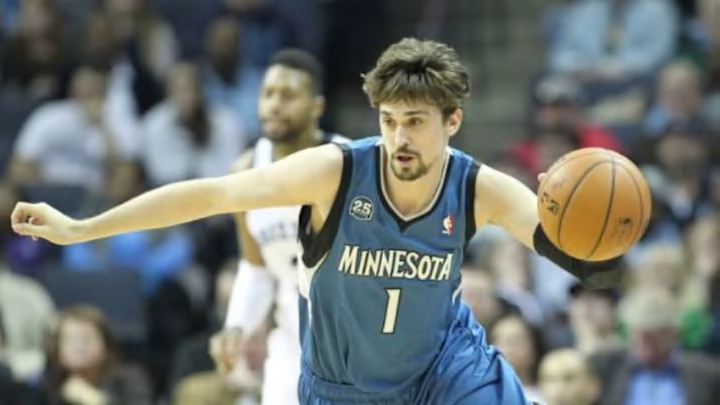Going into the 2013-14, the Minnesota Timberwolves were understandably excited about what to expect from second-year guard Alexey Shved.
Shved had a solid rookie campaign in 2012-13, averaging 8.6 points, 3.7 assists and 2.3 rebounds while playing 23.9 minutes a game and getting 16 starts.
His shooting wasn’t great–.372/.295/.720—but it was expected he would make progress in that regard in his second year.
Heading into the final year of the contract he signed to come over from CSKA Moscow in 2012, Shved’s NBA career is clearly at a crossroads.
His playing time dropped last season despite being mostly healthy (he did sustain a broken nose in January, but didn’t miss any time).
He was a DNP-coach’s decision 19 times last season and averaged only 10.5 minutes in the times he did get on the floor.
But Shved didn’t do a lot with that time. He shot a miserable 32.1 percent overall and hit 29.4 percent of his 3-point attempts.
His assists were way down—from 5.6 per 36 minutes as a rookie to 3.7 last season—and he looked lost at times.
There was one key change from 2012-13 to 2013-14: The absence of his countryman and mentor, Andrei Kirilenko, who signed a free agent deal with the Brooklyn Nets last summer after spending the 2012-13 season with the Timberwolves.
So now Shved is heading to Las Vegas to play with the Timberwolves’ contingent in the Summer League, putting himself in the position of other young players and young veterans who are either trying to capture or keep a roster spot.
Shved’s value has dropped to the point that his name has come up in conjunction with the 2,503,201 Kevin Love trade rumors … as a throw-in.
There is a school of thought that says a switch from Rick Adelman’s corner-set offense to Flip Saunders’ more up-tempo philosophy can’t do anything but help Shved, who is more comfortable when he’s attacking the rim.
If anything else, Shved should be more comfortable playing the 2 spot in Saunders’ offense. In Adelman’s system, Shved often stagnated when playing the off guard spot and not often moving well without the ball, primarily because he was often stationed in a far corner waiting for a kickout pass.
Saunders is bullish on Shved’s potential.
“He’s either going to make a play for a teammate or for himself and he’s going to do it very aggressively,” Saunders said of how Shved fits in the new system. “He puts so much pressure on a defense because of the things he can do.”
The potential is certainly there. Shved scored 25 points while pacing Russia to a bronze-medal victory over Argentina in the 2012 Olympics in London. He averaged 11.3 points, 5.9 assists, 3.1 steals and 3.1 rebounds for Russia in those Games, during which the team went 6-2, with only a two-point loss to Australia in pool play and a 67-59 loss to powerful Spain in the semifinals.
That is the player Minnesota thought it was getting in 2012. The hope is that a new system and a fresh start with a new coach can get Shved closer to being that player, and it begins in Las Vegas with the other hopefuls.
